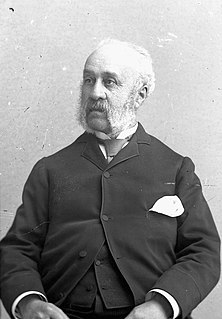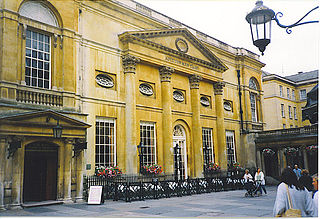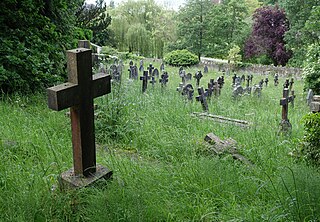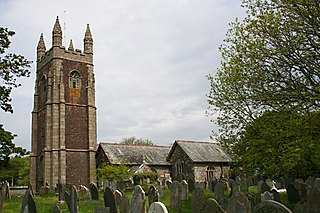Related Research Articles
The year 1817 in architecture involved some significant events.
The year 1768 in architecture involved some significant events.

Thomas Fuller was a Canadian architect. From 1881 to 1896, he was Chief Dominion Architect for the Government of Canada, during which time he played a role in the design and construction of every major federal building.
Thomas Hardwick (1752–1829) was an English architect and a founding member of the Architects' Club in 1791.

Thomas Worthington was a 19th-century English architect, particularly associated with public buildings in and around Manchester. Worthington's preferred style was the Gothic Revival.

Laurel Hill Cemetery is a historic cemetery in Philadelphia. Founded in 1836, it was the second major garden or rural cemetery in the United States. In 1998, it was designated a National Historic Landmark; few cemeteries have received this distinction.
John Pinch the elder was an architect working mainly in the city of Bath, England. He was surveyor to the Pulteney and Darlington estate and responsible for many of the later Georgian buildings in Bath, especially in Bathwick. His son, John Pinch the younger, was also an architect and surveyor to the Pulteney and Darlington estate. His daughter, Celia Pinch, married the silversmith William Holme Twentyman on Mauritius.
John Palmer was an English architect who worked on some of the notable buildings in the city of Bath, Somerset, UK. He succeeded Thomas Baldwin as City Architect in 1792. He died in Bath.
George Phillips Manners was a British architect, Bath City Architect from 1823 to 1862.
Thomas Baldwin was an English surveyor and architect in the city of Bath.
Thomas Warr Attwood was an English builder, architect and local politician in Bath.
The prominent post of Bath City Architect and Surveyor was bestowed by the Corporation of Bath, Somerset, England, on an architect who would be repeatedly chosen for civic projects. The posts were often bestowed separately with surveyor being the first appointment. Surveyors such as Lowder never shared the title with that of City Architect.

Mount Jerome Cemetery & Crematorium is situated in Harold's Cross on the south side of Dublin, Ireland. Since its foundation in 1836, it has witnessed over 300,000 burials. Originally an exclusively Protestant cemetery, Roman Catholics have also been buried there since the 1920s.

St Peter's Church is the parish church of the village of Petersham in the London Borough of Richmond upon Thames. It is part of the Diocese of Southwark in the Church of England. The main body of the church building dates from the 16th century, although parts of the chancel are 13th century and evidence in Domesday Book suggests that there may have been a church on the site in Saxon times. Nikolaus Pevsner and Bridget Cherry describe it as a "church of uncommon charm... [whose] interior is well preserved in its pre-Victorian state". The church, which is Grade II* listed, includes Georgian box pews, a two-decker pulpit made in 1796, and a display of the royal arms of the House of Hanover, installed in 1810. Several notable people are buried in the churchyard, which includes some Grade II-listed tombs.

The Grand Pump Room is a historic building in the Abbey Church Yard, Bath, Somerset, England. It is adjacent to the Roman Baths and is named for water that is pumped into the room from the baths' hot springs. Visitors can drink the water or have other refreshments while there.

The Paragon in the Walcot area of Bath, Somerset, England is a street of Georgian houses which have been designated as listed buildings. It was designed by Thomas Warr Attwood. It now forms part of the A4.

The Anglican Church of St John the Baptist in Midsomer Norton, Somerset, England, is a Grade II* listed building. St. John's is part of the Diocese of Bath and Wells.

The following is a timeline of the history of the city of Bath, Somerset, England.

Smallcombe Cemetery is situated on the edge of Bath, Somerset, England, in a valley between Widcombe Hill and Bathwick Hill. The cemetery consists of two distinct parts, the Anglican section known as St Mary's Churchyard and the non-conformist section known as Smallcombe Vale cemetery. They are sometimes known together as Smallcombe Garden cemetery. The two cemeteries have been closed to new burials since 1988 and they are maintained by Bath and North East Somerset Council. The Bath Corporation assumed responsibility for both cemeteries in 1947. In 1977 the caretakers lodge, described as The Lodge, Bathwick Cemetery, BA2 6DD, was sold for £800 without water or drainage.

The Church of St Mary and St Julian is an active Church of England church in Maker, Cornwall, England, UK. The church dates to the 15th century and has been a Grade I listed building since 1968.
References
- ↑ Historic England (15 October 2010). "THOMAS WARR ATTWOOD TOMB IN CHURCH OF ALL SAINTS CHURCHYARD (1394661)". National Heritage List for England . Retrieved 26 April 2016. "Tomb of Thomas Warr Attwood (d.1775). By Thomas Baldwin. ... Attwood was a prosperous plumber and glazier, who served as architect to the Corporation: he was accidentally killed while surveying the old market. The tomb is designed by his clerk, Thomas Baldwin, who became one of the key architects of late C18 Bath. No 301 on the churchyard plan."
- ↑ Colvin, Howard (1997). A Biographical Dictionary of British Architects, 1600–1840. New Haven: Yale University Press. ISBN 0-300-07207-4.
- ↑ "Discovery of 18th century Architectural drawings". Bath and North East Somerset. Archived from the original on 24 May 2008. Retrieved 7 August 2008.
- ↑ "Annals of Bath, from...1800 to the passing of the new municipal act – Rowland Mainwaring – Google Books". Books.google.com. Retrieved 25 April 2016.
- ↑ "The Building News and Engineering Journal – Google Books". Books.google.com. Retrieved 25 April 2016.
- ↑ "Architects and Artists D-E". Sussex Parish Churches. Archived from the original on 6 October 2010. Retrieved 31 December 2010.
- ↑ Lee, Sidney, ed. (1912). . Dictionary of National Biography (2nd supplement). 1. London: Smith, Elder & Co.